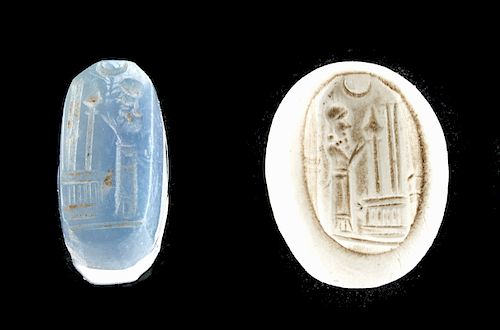Akkadian Chalcedony Stamp Seal Bead w/ Figure in Temple
Lot 53e
About Seller
Artemis Gallery
686 S Taylor Ave, Ste 106
Louisville, CO 80027
United States
Selling antiquities, ancient and ethnographic art online since 1993, Artemis Gallery specializes in Classical Antiquities (Egyptian, Greek, Roman, Near Eastern), Asian, Pre-Columbian, African / Tribal / Oceanographic art. Our extensive inventory includes pottery, stone, metal, wood, glass and textil...Read more
Categories
Estimate:
$2,000 - $3,000
Absentee vs Live bid
Two ways to bid:
- Leave a max absentee bid and the platform will bid on your behalf up to your maximum bid during the live auction.
- Bid live during the auction and your bids will be submitted real-time to the auctioneer.
Bid Increments
| Price | Bid Increment |
|---|---|
| $0 | $25 |
| $300 | $50 |
| $1,000 | $100 |
| $2,000 | $250 |
| $5,000 | $500 |
| $10,000 | $1,000 |
| $20,000 | $2,500 |
| $50,000 | $5,000 |
| $100,000 | $10,000 |
| $200,000 | $20,000 |
About Auction
By Artemis Gallery
Dec 12, 2019
Set Reminder
2019-12-12 10:00:00
2019-12-12 10:00:00
America/New_York
Bidsquare
Bidsquare : Holiday Sale - Antiquities / Ethnographic Art
https://www.bidsquare.com/auctions/artemis-gallery/holiday-sale---antiquities-ethnographic-art-4743
What to give this holiday season? You'll find plenty of options in our Dec. 12 auction that will cater to all tastes and budgets. Artemis Gallery info@artemisgallery.com
What to give this holiday season? You'll find plenty of options in our Dec. 12 auction that will cater to all tastes and budgets. Artemis Gallery info@artemisgallery.com
- Lot Description
**Holiday Shipping Deadlines**
USA Domestic: 12/14 for Standard; 12/23 for Express; International: 12/7 for Standard; 12/19 for Express
Ancient Near East, Akkadian Empire, ca. 2334 to 2154 BCE. A large, pale blue chalcedony stamp seal bead, incised with a figure of a standing worshipper inside a temple. The figure has a distinctive long beard and robes that fall to the floor; the altar it stands before is composed of several tall columns around a low platform. Stemming from the Latin term chalcedonius (chalchedonius), the name chalcedony is mentioned in Pliny the Elder's "Naturalis Historia" as a term for a translucent type of Jaspis. In fact the name most likely derives from the town of Chalcedon in Asia Minor. Size: 0.85" W x 2.7" H (2.2 cm x 6.9 cm)
Known as "kunukku" in Akkadian, royals, government officials, scribes, and slaves used them to transact business and send correspondence. They were worn around the neck or wrist and served as a signature and a guarantee, rolled into the moist clay of accounting and governance documents. They also link our modern world to the past - thousands of years ago, people were concerned with security and authenticity for the documents that they used to conduct business. Cylinder seals were a technological solution to a pressing problem, and their scenes are often complex to prevent forgery and identify individuals.
Provenance: private Zaveloff collection, Lakewood, New Jersey, USA, acquired at auction before 2004
All items legal to buy/sell under U.S. Statute covering cultural patrimony Code 2600, CHAPTER 14, and are guaranteed to be as described or your money back.
A Certificate of Authenticity will accompany all winning bids.
We ship worldwide and handle all shipping in-house for your convenience.
#151420The uncarved end is repaired from multiple pieces; this is well done and difficult to see. Light wear on surface commensurate with age including some small chips and scratches; the motifs are nicely preserved with light deposits, mainly in the lower profile areas. Accompanied by a clay rollout of the motifs.Condition
- Shipping Info
-
All shipping is handled in-house for your convenience. Your invoice from Artemis Gallery will include shipping calculation instructions. If in doubt, please inquire BEFORE bidding for estimated shipping costs for individual items.
-
- Buyer's Premium



 EUR
EUR CAD
CAD AUD
AUD GBP
GBP MXN
MXN HKD
HKD CNY
CNY MYR
MYR SEK
SEK SGD
SGD CHF
CHF THB
THB















